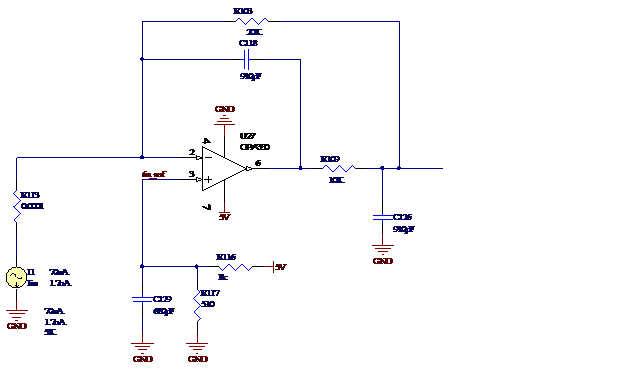Hi, I am working on a design of medium bandwidth medium gain a photo-detector using the OPA380, but I am having difficulty with the frequency response characteristics and hoping someone could help me out.
As I will be adding further filtering stages following the transimpedance amplifier a closed form expression for the circuit is important to me so I can set the poles for the transimpedance stage to 2 of the desired high order Butterworth response poles. The datasheet on page 13 shows equations 4 and 5 that talk about designing a second order response using "in the loop feedback" to generate a second pole (see figure 6c) . I have worked out what I think is a closed form expression for just this stage as:
Rf / (s^2*Cf*Rf*Cfilter*Rfilter + s*Cf*(Rf + Rfilter) + 1)
From this equation 5 follows only if:
Cf*(Rf + Rfilter) = sqrt(2) / w-3dB
However using the design rule from equation 4 in the datasheet for a Butterworth response I do not see this. For example here is my circuit for a gain of 20,000 and a Butterworth response of bandwidth 12.5KHz supposedly (note I have neglected a model of the photo for simplicity, but since the design equations do no reference any of the photo-diode parameters I am assuming the design equations are independent of these).
The circuit above satisfies the design equation 4, i.e Cf*Rf = 2*Cfilt*Rfilt. According to the design equations 4 and 5 in the datasheet this should correspond to a cut-off frequency of f-3dB = 12.4KHz, but based on the transfer function I have calculated above this gives a cut-off frequency of f-6.5dB = 12.4KHz which is 6.5dB down, not the required 3dB for a Butterworth response, indicating this is not a Butterworth response?
To check my work I also simulated the circuit in spice and plotted my theoretical results over my spice simulation which shows close agreement out to the 1MHz of the simulation.
I want to confirm if my model of the system is indeed accurate? If it is why I am not getting the Butterworth response I expect from the information in the datasheet? If not what is a proper closed form model for this system as I will need to set the poles differently than for a second order Butterworth response?
Thanks




